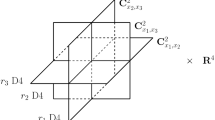Abstract
There are two approaches to constructing stringy multiplications for global quotients. The first one is given by first pulling back and then pushing forward. The second one is given by first pushing forward and then pulling back. The first approach has been used to define a global stringy extension of the functors K 0 and K top by Jarvis–Kaufmann–Kimura, A* by Abramovich–Graber–Vistoli, and H* by Chen–Ruan and Fantechi–Göttsche. The second approach has been applied by the author in the case of cyclic twisted sector and in particular for singularities with symmetries and for symmetric products. The second type of construction has also been discussed in the de Rham setting for Abelian quotients by Chen–Hu. We give a rigorous formulation of de Rham theory for any global quotient from both points of view. We also show that the pull–push formalism has a solution by the push–pull equations in the setting case of cyclic twisted sectors. In the general, not necessarily cyclic case, we introduce ring extensions and treat all the stringy extension of the functors mentioned above also from the second point of view. A first extension provides formal sections and a second extension fractional Euler classes. The formal sections allow us to give a pull–push solution while fractional Euler classes give a trivialization of the co-cycles of the pull–push formalism. The main tool is the formula for the obstruction bundle of Jarvis–Kaufmann–Kimura. This trivialization can be interpreted as defining the physics notion of twist fields. We end with an outlook on applications to singularities with symmetries aka. orbifold Landau–Ginzburg models.
Similar content being viewed by others
References
Atiyah M.F.: K-Theory, pp. v+166+xlix. W. A. Benjamin, Inc., New York (1967)
Arnold V.I., Goryunov V.V., Lyashko O.V., Vasilev V.A.: Singularity Theory I, pp. iv+245. Springer-Verlag, Berlin (1998)
Abramovich, D., Graber, T., Vistoli, A.: Algebraic orbifold quantum products. Orbifolds in mathematics and physics (Madison, WI, 2001). Contemp. Math. 310, 1–24. Amer. Math. Soc., Providence, RI (2002) and Gromov–Witten theory of Deligne–Mumford stacks. Preprint math.AG/0603151
Bott, R., Tu, L.W.: Differential forms in algebraic topology. In: Graduate Texts in Mathematics, vol. 82. Springer-Verlag, New York (1982)
Chen W., Ruan Y.: A new cohomology theory for orbifold. Commun. Math. Phys. 248(1), 1–31 (2004)
Chen B., Hu S.: A de Rham model for Chen-Ruan cohomology ring of abelian orbifolds. Math. Ann. 336(1), 51–71 (2006)
Fantechi B., Göttsche L.: Orbifold cohomology for global quotients. Duke Math. J. 117, 197–227 (2003)
Fulton, W., Lang, S.: Riemann-Roch algebra. Grundlehren der Mathematischen Wissenschaften, vol. 277. Springer-Verlag, New York (1985)
Greene B.R., Plesser M.R.: Duality in Calabi-Yau moduli space. Nucl. Phys. B 338(1), 15–37 (1990)
Hirzebruch, F.: Topological methods in algebraic geometry. Die Grundlehren der Mathematischen Wissenschaften, Band 131, x+232 pp. Springer-Verlag, New York (1966)
Jarvis T., Kaufmann R., Kimura T.: Pointed admissible G-covers and G-equivariant cohomological field theories. Compos. Math. 141, 926–978 (2005)
Jarvis T., Kaufmann R., Kimura T.: Stringy K-theory and the Chern character. Inv. Math. 168(1), 23–81 (2007)
Kaufmann, R.M.: Orbifold Frobenius algebras, cobordisms, and monodromies. In: Adem, A., Morava, J., Ruan, Y. (eds.) Orbifolds in Mathematics and Physics. Contemp. Math., vol. 310, pp. 135–162. Amer. Math. Soc., Providence (2002)
Kaufmann R.M.: Orbifolding Frobenius algebras. Int. J. Math. 14, 573–619 (2003)
Kaufmann, R.M.: Discrete torsion, symmetric products and the Hilbert scheme. In: Hertling, C., Marcolli, M. (eds.) Frobenius Manifolds, Quantum Cohomology and Singularities. Aspects of Mathematics E 36. Vieweg (2004)
Kaufmann R.M.: Second quantized Frobenius algebras. Commun. Math. Phys 248, 33–83 (2004)
Kaufmann R.M.: The algebra of discrete torsion. J. Algebra 282, 232–259 (2004)
Kaufmann R.M.: Singularities with symmetries, orbifold Frobenius algebras and mirror symmetry. Contemp. Math. 403, 67–116 (2006)
Kaufmann, R.M.: Stringy multiplication for orbifold Landau–Ginzburg theories. Preprint
Lerche, W., Vafa, C., Warner, N.P.: Chiral rings in N = 2 superconformal theories. Nucl. Phys. B 324(2), 427–474 (1989)
Quillen D.: Elementary proofs of some results of cobordism theory using Steenrod operations. Adv. Math. 7, 29–56 (1971)
Author information
Authors and Affiliations
Corresponding author
Rights and permissions
About this article
Cite this article
Kaufmann, R.M. Global Stringy Orbifold Cohomology, K-Theory and de Rham Theory. Lett Math Phys 94, 165–195 (2010). https://doi.org/10.1007/s11005-010-0427-z
Received:
Accepted:
Published:
Issue Date:
DOI: https://doi.org/10.1007/s11005-010-0427-z



